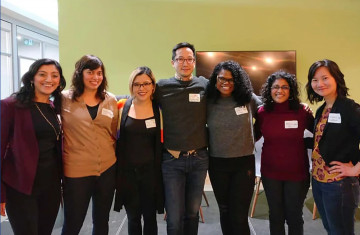Time for action on diversity
There’s been lots of talk around the lack of media diversity in Canada, but it’s been mostly lip service. Anita Li explains why calls to action from Canadian Journalists of Colour and the Canadian Association of Black Journalists need to finally be acted on, now.

(L to R) Canadian Journalists of Colour Toronto organizers Sadiya Ansari, Natasha Grzincic and Anita Li with panelists Jason Chiu (formerly of The Globe and Mail), Xtra's Eternity Martis, CBC's Seema Patel and Huffpost Canada's Andree Lau at a CJOC event in Toronto.
I am grateful for the opportunity to write about the recent calls to action to improve diversity in Canadian media by Canadian Journalists of Colour (CJOC). But I also feel tired.
Addressing the lack of data on representation in media in Canada and what our society loses when we only get to read limited perspectives on the news would absolutely provide meaningful context for readers. So why do I hesitate?
Because the information is already out there; because people have discussed the value of diversity from a business, civic and moral standpoint for decades; and because I myself have explained the importance of a diverse Canadian media many, many, many, many times before.
In fact, all this diversity talk is precisely why the CJOC and the Canadian Association of Black Journalists (CABJ) decided to partner up to release our calls to action in the first place — emphasis on the word “action.” As a journalist of colour who’s worked in the industry for more than half my life, I know this conversation about media diversity in Canada is an old one, but it’s never really gone beyond lip service. That must stop now.
When we first published the calls to action in late January, they went viral in our industry, with my announcement tweet alone attracting hundreds of retweets and likes from high-profile journalists (both managers and rank and file), media unions and journalism educators, as well as members of the news-consuming public in Canada and around the world. There’s also been plenty of media coverage, with both CJOC and CABJ fielding requests several weeks after our initial release.
It’s easy to click “like,” get a warm fuzzy feeling for your good deed and promptly forget about it.
I’m heartened by the attention and largely positive response our CTAs have gotten, especially since one of our goals was to sustain the conversation about Canada’s media diversity in the public sphere. But a proclamation of support is still just a proclamation. Unfortunately, our document is as legally binding as the Paris Agreement — which is to say not at all.
It’s easy to click “like,” get a warm fuzzy feeling for your good online deed and promptly forget about it after leaving your computer, which is why likes don’t always lead to action. That’s what two well-respected journalists of colour, who for years took on the emotional labour of educating Canadians about the importance of diversifying media, effectively warned me about via private message about our CTAs: They’ll be ignored; they’ll be dismissed; they’ll go unheard.
These two industry leaders weren’t trying to be unsupportive — they were being honest and realistic, based on their years of experience. As I mentioned earlier, the information we need to move forward has existed for a while, but the people in power still haven’t changed things.
Although I understand my colleagues’ perspective and am also a realist at heart, I'm optimistic that our CTAs will have an impact because of the current reality. Public appetite for conversations about diversity in media have grown significantly over the past couple of years, thanks in part to former Globe and Mail reporter Sunny Dhillon’s viral Medium post about the discrimination he faced at Canada’s newspaper of record, the outcry to a Vancouver Sun op-ed that suggested ethnic diversity is harmful, and the widespread criticism the Canadian media received for its reductive coverage of Prime Minister Justin Trudeau wearing blackface and brownface. Greater awareness means a better-educated public, which will lead to more demand for diverse stories from journalists of all backgrounds — and ultimately much-needed change.
Everyone deserves to see their lives reflected in the stories they read, hear and watch. Anything less is erasure.
Given the renewed focus on subscriptions as a major revenue source for news publications, more audiences will result in more opportunities to earn money. In addition, introducing one community’s stories to another will foster better understanding between different groups of people during a time of extreme polarization.
Beyond the business and civic cases for diversifying media, everyone deserves to see their lives reflected in the stories they read, hear and watch every day, because anything less than that is erasure. Indeed, anything less than that isn’t Canada.
I refuse to wait on the sidelines any longer for change to come, which is why CJOC wants to work with stakeholders to develop programming that will make each of our CTAs a reality. For one example, for “Begin self-reporting of newsroom demographics on a regular basis,” I’d love to invite a group of editorial managers and diversity and inclusion (D&I) committee heads to a workshop where we co-create a framework for monitoring and measuring newsroom demographics, because people are far more likely to take action on something when they feel ownership.
Already, several stakeholders have contacted CJOC to collaborate, including unions, potential funders and both establishment and startup media outlets. But it’s still early days. So we need more firm commitments and funding to ensure these calls to action don’t just stay calls to action. Help us walk the walk, and change Canadian journalism for the better.
